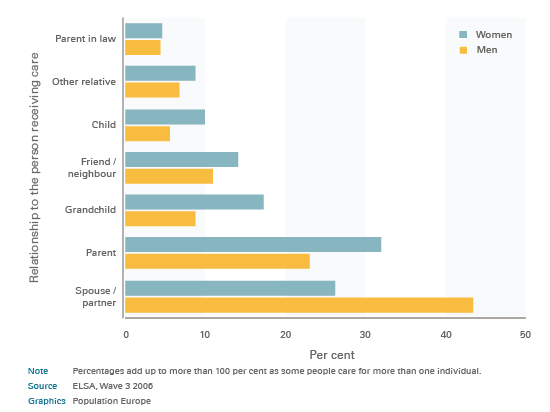Caring for one's spouse who suffers from long-term physical or mental impairments, giving a hand to an older neighbour by assisting with everyday activities in the household or looking after oneˆs grandchildren ? care provided outside of formal care institutions comes in many different guises. In this context, a recent study by Athina Vlachantoni from the University of Southampton sheds light on how, in particular, people in mid and late life fare as providers of informal care.
Based on data from the English Longitudinal Study of Ageing (ELSA) 2006, the analysis explores questions about mid and late life carers such as: Who cares for whom? Who belongs to the group of “round-the-clock-carers”? And finally, how is the provision of informal care by older people interrelated with their own health and labour market integration?
Who cares for whom and when?
According to the results of the study, in the UK about 9 percent of men and 15 percent of women aged 50 years or over actively provided informal care to someone in 2006.
Mostly, carers belonged to the “younger old” aged 50 to 64 years. The probability of caring for someone decreases with age from 12 percent of those from 50 to 59 years of age to less than 5 percent among those aged 80 years and over.
Caring can be quite a different experience for men and women: Many women look after their parents and parents-in-law, children, grandchildren, friends or neighbours. Men – if they provide informal care – tend to do so for their spouses. However, they sometimes continue to do this until very late life: 6 percent of men aged 80 years and over still care for their spouse (see figure 1).

Figure 1: Relationship of male and female carers to the person they care for (2006)
In terms of time devoted to care, the study shows that more than half of mid and late life carers provided between 1 and 19 hours of care per week. However, one-fifth looks after someone 24 hours a day, seven days a week. Of these “round-the-clock-carers” one in two is aged 65 years or older and in this group the proportion of men and women is almost equal. However, the men in this group almost exclusively provide such intensive care responsibilities for their spouse or partner (88%), whereas female round-the-clock carers are also likely to look after a parent or parent-in-law (16%) or a child or a grandchild (22%).
The health of the care givers
As the study shows, several million Britons provide informal care – quite a few of them even round-the-clock – at an age when many start to suffer from age-related health impairments themselves. This raises the question of how they fare with respect to their own health.
According to Vlachantoni’s study, older carers report better health than older non-carers. However, the proportions of carers who evaluate their own health status as good decreases with increasing care intensity. For example, while 78% part-time carers with up to 19 hours of informal care think they are in good health, this is only the case for 60 percent of carers providing 50 hours or more.
Although the results of the analysis cannot provide information about the causal relationship between health and informal care provisions, they do allow for two interpretations: It is healthier individuals who take on care responsibilities in the first place, and high care intensity often goes hand in hand with poorer health.
Caring and Career: Reconcilability or Crowding Out?
Almost two-thirds of mid and late life carers are between 50 and 64 years old. Hence, many are still in the active labour market phase of their lives. Do they manage to reconcile informal care with labour market participation, or does taking on care responsibilities lead to a crowding out of gainful employment?
The results of the study quite clearly support the crowding out hypothesis: Among 50-64 year-old caregivers, only 50 percent are employed or self-employed, whereas this is the case for 64 percent of their cohorts not engaged in informal care. Moreover, the more hours a carer invests, the less likely it is that he or she is active in the labour market. However, further research is needed to determine whether people do not or only little engage in informal care as long as they are active on the labour market, or whether they cut down their work activity in order to provide informal care for their loved ones.
These interdependencies, as well as the impact of caregiving on ones own health will be important to explore as ageing societies will need more rather than less informal care in the future.
This PopDigest is also available in French, Spanish and German.
This volume has been published with financial support of the European Union in the framework of Population Europe.